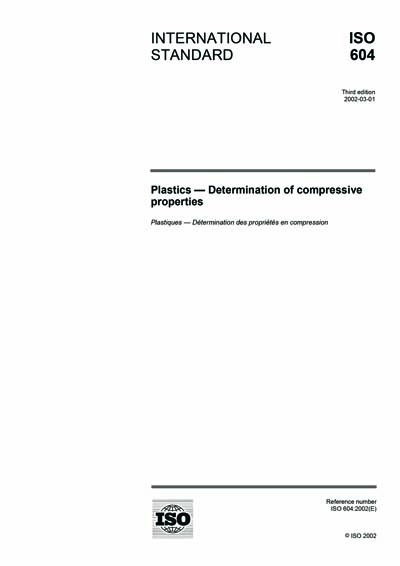Most recent
ISO 604:2002
Plastics - Determination of compressive properties
This International Standard specifies a method for determining the compressive properties of plastics under defined conditions. A standard test specimen is defined but its length may be adjusted to prevent buckling under load from affecting the results. A range of test speeds is included.
The method is used to investigate the compressive behaviour of the test specimens and for determining the compressive strength, compressive modulus and other aspects of the compressive stress/strain relationship under the conditions defined.
The method applies to the following range of materials:
- rigid and semi-rigid[1] thermoplastic moulding and extrusion materials, including compounds filled and reinforced by e.g. short fibres, small rods, plates or granules in addition to unfilled types; rigid and semi-rigid thermoplastic sheet;
- rigid and semi-rigid thermoset moulding materials, including filled and reinforced compounds; rigid and semirigid thermoset sheet;
- thermotropic liquid-crystal polymers.
In agreement with ISO 10350-1 and ISO 10350-2, this International Standard applies to fibre-reinforced compounds with fibre lengths ≤ 7,5 mm prior to processing.
The method is not normally suitable for use with materials reinforced by textile fibres (see references [2] and [5]), fibre-reinforced plastic composites and laminates (see [5]), rigid cellular materials (see [3]) or sandwich structures containing cellular material or rubber (see [4]).
The method is performed using specimens which may be moulded to the chosen dimensions, machined from the central portion of a standard multipurpose test specimen (see ISO 3167) or machined from finished or semifinished products such as mouldings or extruded or cast sheet.
The method specifies preferred dimensions for the test specimen. Tests which are carried out on specimens of different dimensions, or on specimens which are prepared under different conditions, may produce results which are not comparable. Other factors, such as the test speed and the conditioning of the specimens, can also influence the results. Consequently, when comparable data are required, these factors must be carefully controlled and recorded.
1) To be published. (Revision of ISO 295:1991)
International Organization for Standardization [iso]


